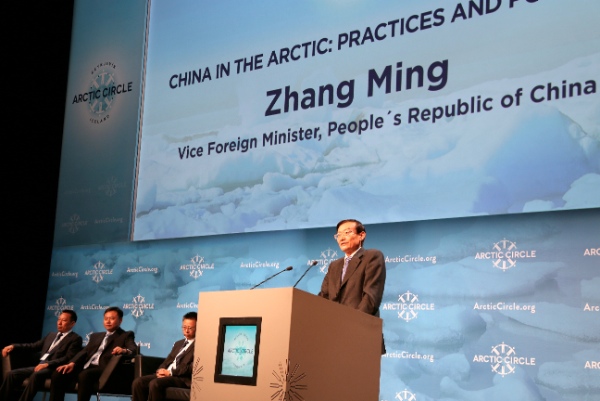
China has said it is a major arctic stakeholder even as melting permafrost caused by rising global temperatures has made the once impenetrable Arctic Circle increasingly accessible and coveted.
At the three-day Arctic Circle Assembly that opened in Iceland on Friday, Chinese Vice Foreign Minister Zhang Ming dwelt in detail on China’s scientific research, shipping, oil and gas exploration as well as climate change research in the Arctic.
“China is a major stakeholder in the Arctic,” Zhang said.
In 1925, Beijing acceded to the Svalbard Treaty, which marked the beginning of China’s participation in the Arctic region.
Since the 1990s, China’s involvement in Arctic activities has expanded considerably.
“What has happened shows that China is a constructive participant in and partner of cooperation in Arctic affairs. Going forward, China is willing and able to make even greater contribution to the sustainable development of the Arctic,” said Zhang.
A high-level Chinese delegation, headed by Chinese Vice Foreign Minister Zhang Ming, attended the assembly and hosted a country session themed “China’s contribution”.
Earlier in a video message to the meet at ReykJavik, capital of Iceland, Chinese Foreign Minister Wang Yi also stressed on China’s “near-Arctic state status”.
Foreign ministers of Arctic nations, as well as key stakeholders from non-Arctic states including China, underscored the urgency of combating climate change at a summit in Alaska in August.
The US has assumed chairmanship of the Arctic Council in 2015. The US has held interests in the Arctic since it bought Alaska from Russia in 1867.
Arctic nations have long vied for the potentially valuable resources beneath the northern seas.
The US geological Survey in 2008 said the Arctic Circle has an estimated 90 billion barrels of recoverable oil, 1,670 trillion cubic feet of recoverable natural gas, and 44 billion barrels of recoverable natural gas liquids.
China has one research station in the Arctic, the Yellow River Station and a Polar Research Institute in Shanghai to train scientists in Arctic research. In 2015, China will launch three research expeditions to the Arctic.
Russia boasts of hosting half of the arctic coastline.
Russia has made claims on several Arctic shelf areas and is planning to defend its bid at the UN. Canada, US and Denmark also lay claim to parts of the resource-rich shelf.
Meanwhile, China and India were granted observer status in the Arctic council after an announcement at a ministerial meeting in Sweden in 2013.
China and India can now sit in on meetings at the Arctic Council without voting. The Arctic Circle has been looking to incorporate more inclusive debate about the future of the Arctic region.
At present, only the eight countries of the Arctic Council have a say in setting policy in the region – America, Canada, Denmark, Finland, Norway, Russia, Sweden and Iceland.
The Arctic is expected to become ice-free in coming decades as temperatures there rise twice as fast as in the rest of the world, which has led to a major push by oil and mining companies to drill in Arctic waters, and by Asian countries hoping to cut shipping routes.
US Secretary of State John Kerry has said the Arctic has enormous national security implications for the US.
“For a long time now, I’ve shared the view that the Arctic region really is the last global frontier, and the United States needs to elevate our attention and effort to keep up with the opportunities and consequences presented by the Arctic’s rapid transformation,” Kerry said last year.